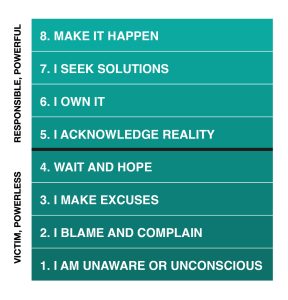The Accountability Ladder – taken from “The Oz Principle – Getting Results Through Individual and Organizational Accountability,” where accountability is defined as “a personal choice to rise above one’s circumstances and demonstrate the ownership necessary for achieving the desired result.”

The Accountability Ladder is a great tool which helps managers work out where their employees may be on the ladder of accountability. The 8 steps are:
- The lowest level is someone who is unaware/unconscious of the situation. This may be someone who is new or just not aware as to what the expectations are.
- The second level moving upward is someone who blamesor complains about others�for what is going on – the systems, the clients, the market, their colleagues etc
- The third level on the ladder is making excuses.�A person who rationalizes why something didn’t happen or why they didn’t achieve what they set out to achieve. “I’ve been doing it this way for ages, it’s worked just fine”
- Level four is hope it goes away.This is someone who thinks that if they just wait long enough, or wait until the boss isn’t looking, they can go back to doing what they want to do and it’ll somehow come good
Levels one through four are considered “Below the line” or ‘victim’ positions where people believe things are happening ‘to them’. With below the line, we hear things like
“That’s the way we’ve always done it.”
“It’s not my job.”
“I didn’t know you needed it right away.”
“It’s not my fault.”
“No one told me what to do.”
“I don’t know.”
“I forgot.”
“I’m too busy to do it.”
‘Nobody’s followed up with me, it can’t be that important.”
The next four levels are considered to be “Above the Line” positions on the ladder, and are more proactive and empowered positions. This is where people who take responsibility sit
- Level five is acceptance.�They accept the new changes, process, system, direction, focus etc
- Level six is where they ‘own it’ This is someone who is not only accepting of whatever, that it’s part of their role, and that they need to do something with it
- Level seven is seek solutions.�This is where they proactively look for solutions to challenges and situations
- And finally level eight is making it happen!�This is the ‘just do it’ people do what it takes to get the job done.
As a manager take a moment to identify where your team are (and also where you may be). If you or others are above the line, fantastic, let’s give the feedback and help them get to the top.
Moving Up the Ladder –�So how do we get others or ourselves above the line? Take a few moments to answer the following questions:
- What is within your control?
- What brings you here every day?
- What is working for you?
- What are your strengths?
- What do you enjoy?
What do these questions have in common? They are all positively focused. Spending the time to answer them can give people a new perspective or place the focus on the positives. These are great questions to ask your employees if you feel they are struggling below the line. Questions like these can really open up discussion and help someone refocus.
Coaching People to get Above the Line –�There are five steps to follow when coaching others above the line. These include:
- Actively listen
- Acknowledging what is being said
- Asking
- Providing feedback on how to move forward
- Committing to support their efforts
The most critical piece of this coaching model is number three. After you have spent time listening and acknowledging your employee’s current challenges, the question you need to ask them is, “Given your current circumstances, what else can you do to move forward?” This helps shift them from victim mode to action. Once they begin to talk about what else can be done, make sure you provide them with the feedback and the support they need to move ahead.
All of us have been below the line. The Accountability Ladder is a great way to diagnose where you or your team are. It provides the ability to understand and coach people work through the reasoning of why living “Below the Line”�will get in the way of our satisfaction and success.

